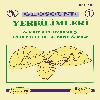Mineral association and significance of the Efemçukuru epithermal gold deposit, İzmir-Turkey
Efemçukuru epitermal altın yatağının (İzmir) mineral parajenezi ve önemi
___
- Andiç, E. and Eşder, T., 1981. Geological report of the Pb-Zn-Cu-Mn Mineralisation in İzmir-Efemçukuru-Kavacık. Mineral Res. and Exp. Gen. Dir. Of Turkey, Ankara, report.
- Ataman, G. 1975. Plutonisme calcalkalin d'age Alpin en Anatolie du norduest. C.R. Acad. Sc. Paris: D 280, 2065-2068.
- Bingöl, E. 1976. Geotectonic evolution of Western Anatolia. Bull. Min. Res.Exp. Inst. Turk. 86,14-35.
- Borsi, S., Ferrara, G., Innocenti, F., and Mazzuoli, R., 1972. Geochronology and Petrology of recent volcanics in the eastern Agean Sea (Western Anatolia and Leshos Islands). Bui. Vole. XXXVI3, 473-496.
- Erdoğan, B., 1985. Stratigraphic and structural features of the Bornova Melange. Geol. Cong. Turkey, Chamber of Geol. Eng. Turkey, p.14.
- Hedenquist, J.W., 1990. The thermal and geochemical structure of the Broadlands-Ohaaki geothermal system. New Zealand. Geothermics 19,151-185.
- Hedenquist, J.W. and Lowenstern, J.B. 1994. The role of magmas in the formation of hydrothermal ore deposits. Nature 370, 519-527.
- Hedenquist, J.W. and Stewart, M.K., 1985. Natural CO2 rich steam heated waters at Broadlands, New Zealand: Their chemistry, disturbution and corrosive nature. Geothermal Resources Council Annual Meeting Transactions, 9, 245-250.
- Krushensky, R.D., 1976. Neogene calc-alcaline extrusive and intrusive rocks of the Karalar-Yeşiller area. Northwest Anatolia, Turkey. Bull. U.S.A. Geol. Survey. 1461,1-72.
- Qyman, T. 2000. Kalsik bor -silikatların duraylılık alanlarının deneysel incelenmesi; Ege Bölgesi (Türkiye) hidrotermal mineralizasyon sistemlerine uygulanması. Doktora tezi, Dokuz Eylül Üniversitesi, İzmir- Türkiye.
- Pişkin, Ö., Delaloye, M. and Fontignie, D. 1983. Donnees petrochimiqes et geochronologiques sur le magmatism de la peninsule de Bodrum. Sud-ouest de la Turquie. Eclogae geol. Helv. 76(2), 309-315.
- Savaşçın, M.Y. and Güleç, N. 1990. The relationship between magmatic and tectonic activities in Western Turkey. With examples from the coastal section. International Earth Sciences Colloquium On The Aegean Region. Abstracts.
- Simmons, S.F., and Browne, P.R.L. 2000. Hydrothermal minerals and precious metals in the Broadlands-Ohaaki geothermal system: Implications for understanding low-sulfidation epithermal environments. Econ. Geol. 95, 971-1000.
- ISSN: 1019-1003
- Yayın Aralığı: 1
- Başlangıç: 1986
- Yayıncı: Çukurova Üniversitesi Jeoloji Mühendisliği Bölümü
Anamur (Mersin) kuzeydoğusunun tektono-stratigrafik özellikleri
Kemal ZORLU, Hayati KOÇ, Erol ÖZER, Abdullah ALTUNCU
Kızlaç T3A tünelinde nihai yerdeğiştirmelerin tahmini (Bahçe /Osmaniye)
Erzurum şehir merkezi batı kesiminin jeoteknik özellikleri
Necmi YARBAŞI, M. Salih BAYRAKTUTAN
Emin ÇİFTÇİ, Bülent YALÇINALP, Hasan KOLAYLI, Richard D. HAGNI
Madenli (Gelendost-Isparta) manyezit cevherleşmesinin jeolojisi ve jeokimyasal özellikleri
Jeogrid ve jeotekstil ile şev destekleme sistemi tasarım esasları ve bir örnek uygulama
